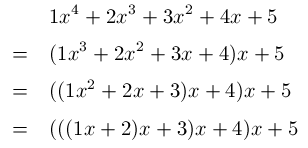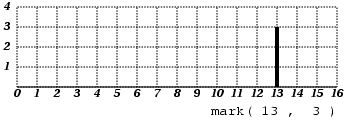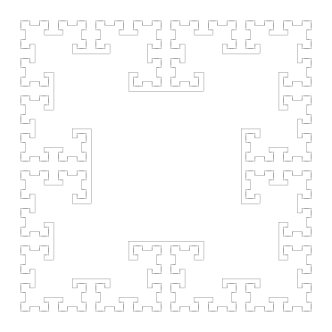f(n) = n + (n-1) + ... + 2 + 1 
(1) Wirite recurrence formulas for the following sequences.
f(n) = n!f(n) = 20 + 21
+ 22 + ... + 2n 1, 1, 2, 3, 5, 8, 13, 21, 34, ...
(n)f(x,n) = a0 xn +
a1 xn-1 + ...
an-1 x + an
[Use Horner method]
(2) Consider the following function rule() below which uses a function mark().
mark() draws a line to the rule.
For example, mark( 13, 3 ) draws a line of height 3 in the position 13.
Illustrate in sequential order how the linse are drawn, when rule( 4, 12, 3) is executed.
void rule(int left, int right, int height){
int middle = (left+right)/2;
if( height>0 ){
mark(middle, height);
rule(middle, right, height-1);
rule(left, middle, height-1);
}
}
The following equation is an example of recurrence formula for an arithmetic sequeence with the first term equal to 1 and with the difference equal to 1
f(n) = n + (n-1) + ... + 2 + 1

The Horner method is a method of expanding the higher order polynomial in the form of (ax + b).
For example, f(x) = 1x4 + 2x3 + 3x2 + 4x
+ 5
is expanded by the Horner method as follows

The following figure is an example of line drawn by mark(13,3)< br />

Write the C-functions which perfrom the calculations specified below using recurseve calls:
f(x) = 1x4 + 2x3 + 3x2 + 4x
+ 5
Call these functions in main() and
calculate the following:
f(x) = 1x4 + 2x3 + 3x2 + 4x
+ 5Example of executing a program: % ./a.out 10! = 3628800 2^0 + 2^1 + 2^2 + ... + 2^9 + 2^10 = 2047 fibonacci 20: 6765 f(2) = 57.00
You may declare the coefficients an which are used by the Horner method as global array, since it is easy.
For example,
#define N 4
double a[N+1] = { 1, 2, 3, 4, 5 };
The array and the expansion correspond as it is shown on the figure:

ex04-3-skel.c
is a program which creates a PostScript file star.ps. A following image is drawn in the
star.ps.

Edit this program and create
a PostScript file
in which the following image is drawn.

A function star() draws imege in this program. Edit this function.
A function line() which used in star() draws lines.
For example, line(1,2,3,4) draws line
from position (1,2) to position (3,4).
If you finish this question, please try Koch curve.